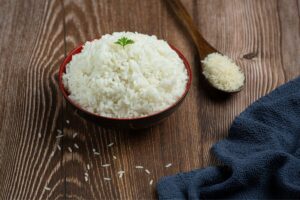Do you love the delicious taste of coconut rice but don’t have any coconut milk at home? No worries! You can still enjoy this delightful dish without it.

Welcome to our guide on making coconut rice without coconut milk. Yes, you read that right!
We’ll walk you through a simple and ingenious way to create this flavorful rice dish using easy-to-find ingredients that might already be in your pantry. Let’s dive in.
Coconut Cream
Coconut cream is the thicker, richer part of coconut milk that naturally separates from the lighter milk when coconut milk sits undisturbed.
It’s luscious and carries a more concentrated coconut flavor, making it a great substitute in recipes that call for coconut milk.
To use coconut cream as a substitute for coconut rice, dilute it with water to achieve the desired consistency.
Start by mixing the coconut cream with an appropriate amount of water until it reaches a consistency similar to coconut milk. Adjust the ratio based on the creaminess you prefer in your coconut rice.
Coconut Water
Coconut water can infuse a subtle coconut flavor into dishes like coconut rice. While it doesn’t have the creamy consistency of coconut milk, it imparts a delicate tropical essence.
Use it as part of the cooking liquid for the rice to infuse it with a hint of coconut taste.
If substituting coconut water for coconut milk in a recipe, consider adjusting the overall liquid content.
Since coconut water is thinner and less creamy than coconut milk, you might need to compensate by adding a thicker liquid or adjusting the proportions of other ingredients for desired consistency and taste.
Plant-Based Milk
Plant-based milks, such as almond, soy, or oat milk, serve as excellent alternatives to coconut milk in various recipes. These milks are made by soaking and blending nuts, seeds, or grains with water and then straining the mixture.
They offer a creamy texture and distinct flavors, making them versatile in cooking.
When using them as a substitute for coconut milk in coconut rice, simply replace the coconut milk with an equal amount of your chosen plant-based milk, adjusting as needed for taste and consistency.
Rice, in its various forms, is a staple food for many cultures around the world. It’s versatile and easy to cook, and when infused with the tropical richness of coconut, it becomes an irresistible dish that tantalizes the taste buds.
Coconut rice, a classic in Southeast Asian and Caribbean cuisines, offers a delightful twist to the traditional white rice.
Shredded Coconut

If using shredded coconut, soak it in warm water or coconut milk beforehand to rehydrate it. This adds texture and a more subtle coconut essence to the rice.
Ingredients You’ll Need
– 1 cup of long-grain white rice
– 1 cup of coconut milk alternatives like coconut water, cream, or shredded coconut
– 1 cup of water
– 1 tablespoon of coconut oil (or any cooking oil of your preference)
– 1/2 teaspoon of salt
– Optional: Fresh herbs (like cilantro) or toasted coconut flakes for garnish
Cooking Directions
Step 1: Choosing Your Coconut Ingredient
Before diving into the cooking process, let’s explore the options for infusing your rice with coconut flavor:
Step 2: Preparing the Rice
Rinse the Rice: Place the rice in a fine-mesh strainer and rinse it under cold water until the water runs clear. This removes excess starch and prevents the rice from becoming too sticky while cooking.
Afterwards, you select your cooking pot. It’s always recommended you opt for a medium-sized saucepan with a tight-fitting lid.
Step 3: Cooking Process
Sautéing: While cooking, heat the coconut oil in the saucepan over medium heat. Once hot, add the rinsed rice and sauté it for about a minute, stirring constantly until it’s lightly toasted.
This step helps to enhance the nutty flavor of the rice.
Adding Liquid: Now, pour in your choice of coconut ingredient (coconut water, cream, or soaked shredded coconut). Add a cup of water salt and stir gently to combine.
Bringing to a Boil: Increase the heat and bring the mixture to a gentle boil.
Simmering: Once boiling, reduce the heat to low, cover the saucepan with the lid, and let the rice simmer for about 15-20 minutes. Avoid lifting the lid during this process as it disrupts the steaming and cooking.
After 15 minutes, check the rice. If the liquid has been absorbed and the rice is tender, remove it from the heat. If not, let it cook for a few more minutes.
Once done, fluff the rice gently with a fork. You can add some fresh herbs like cilantro or a sprinkle of toasted coconut flakes for a flavorful and aesthetic touch.
Cooking Coconut Rice in a Rice Cooker
Ingredients
– 1 cup of long-grain white rice
– 1 cup of coconut milk
– 1 cup of coconut water
– 1/2 teaspoon of salt

Instructions:
Step 1: Preparing the Rice Cooker
Rinse the Rice: Place the rice in a fine-mesh strainer and rinse it thoroughly under cold water until the water runs clear. This helps remove excess starch for fluffier rice.
Add Ingredients to the Rice Cooker: In the rice cooker bowl, combine the rinsed rice, coconut milk, coconut water, and salt. Ensure the rice cooker is switched off before adding ingredients.
Step 2: Setting and Cooking
Select the Cooking Setting: Depending on your rice cooker’s options, choose the setting suitable for white rice or the regular cooking mode.
Each rice cooker may have slightly different settings, so refer to the manufacturer’s instructions.
Start Cooking: Close the lid and turn on the rice cooker. The cooker will automatically adjust the cooking time based on its sensors. Generally, two cups of rice will take approximately 20-25 minutes to cook.
Step 3: Allowing Steaming Time
Switch to Warming Function: Once the rice cooker finishes cooking, it will switch to a warming function to keep the rice warm and let it steam further.
Steam the Rice: Allow the rice to sit in the rice cooker, covered, for an additional eight minutes. This helps the rice absorb any remaining moisture and ensures an even texture.
Step 4: Adding Flavorings
Fluff the Rice: After the steaming process, remove the lid and fluff the rice gently with a fork to separate the grains.
Incorporate Extras: If desired, this is the perfect time to add any additional flavorings like fresh herbs, a splash of citrus juice, or vegetables. Gently stir these ingredients into the rice to distribute the flavors evenly.
Conclusion
In conclusion, creating delicious coconut rice without coconut milk is absolutely doable and just as tasty.
By using simple ingredients like shredded coconut, coconut oil, or coconut water, you can achieve that delightful coconut flavor in your rice dishes.
Experimenting with these alternatives allows for versatility in your recipes, catering to various dietary needs or ingredient availability.
With these tips, you can enjoy the delightful taste of coconut-infused rice in a way that suits your preferences and taste.
